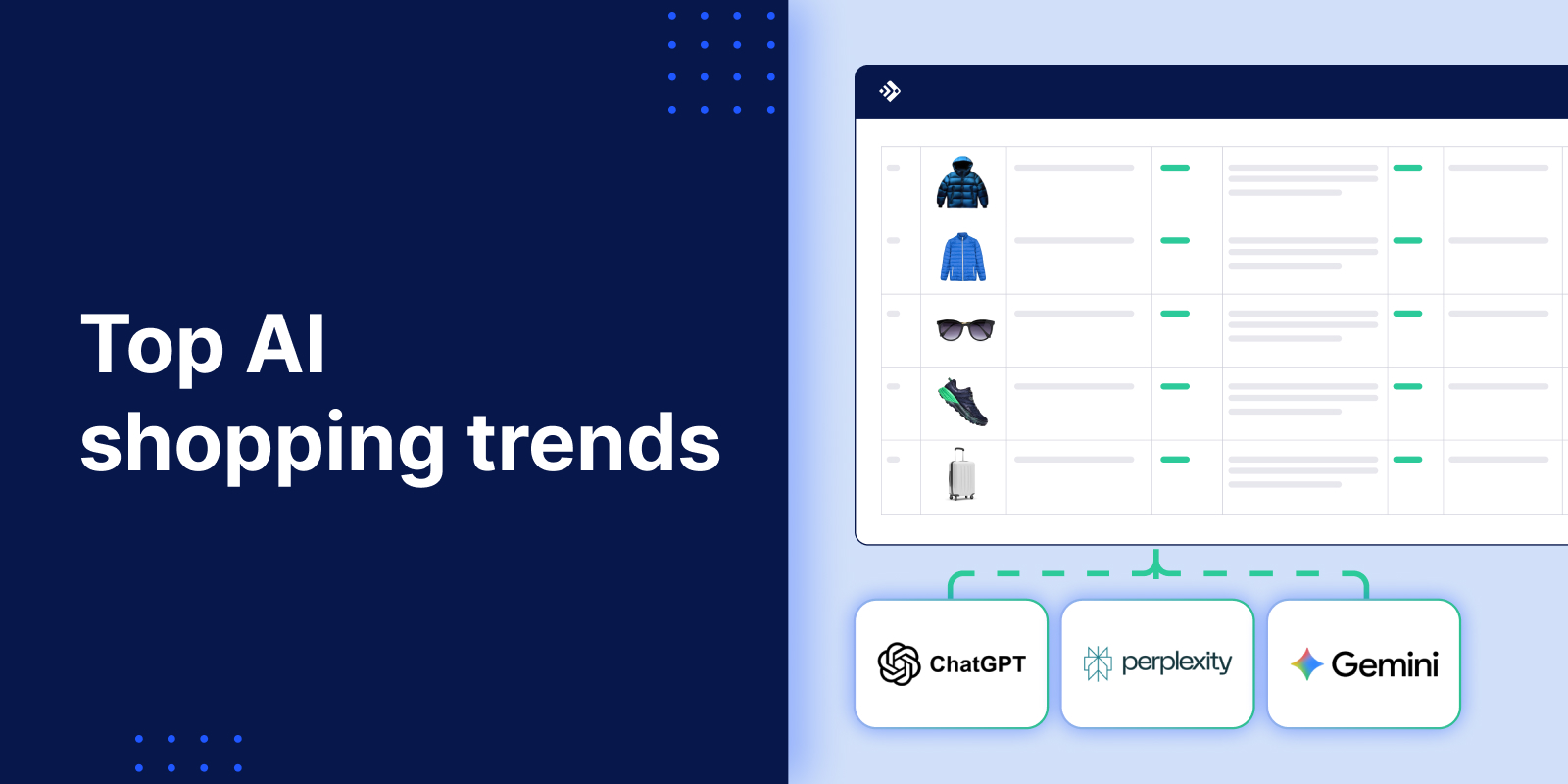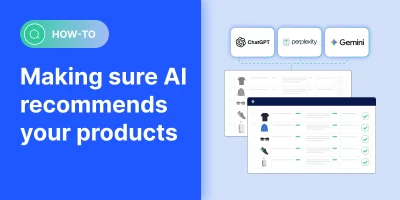People already turn to ChatGPT for casual therapy sessions and late-night confessions—so is it really such a stretch that they’re now asking it which office chair has the best lumbar support?
Generative AI tools like ChatGPT, Perplexity, and Gemini are quickly becoming core companions in the shopping journey. Millions of people across all ages and lifestyles aren’t using these tools out of novelty; they’re paying for them, relying on them, and shopping through them.
What makes these platforms so powerful isn’t just their conversational interfaces—it’s the context they gather. A single line like “I’m a 35-year-old coffee shop owner in Seattle, Washington” gives AI all the ingredients it needs to serve up personalized recommendations. Ask it, “What kind of everyday shoes would work best for me?” and it won’t just show sneakers—it’ll show your sneakers perfect for transitioning between rainy and sunny days.
It’s not just generative AI either. Whether they know it or not, shoppers are interacting with all kinds of AI systems to cut through digital noise and find products that fit their lives, preferences, and budgets.
In our 2025 omnichannel trends blog, we explored how AI is transforming ecommerce from both sides of the transaction. In this post, we’re zeroing in on the shopper’s point of view, highlighting how real consumers are already using AI to make smarter, faster, and more confident buying decisions.
Understanding these behaviors is critical for ecommerce businesses that want to meet customers where they are and stay ahead where new tech influences consumer behavior.
#1 Discovering products via generative AI
A growing number of shoppers are turning to generative AI tools like ChatGPT, Perplexity, and Google AI Mode (powered by Gemini) to discover products in a more conversational, intuitive way.
Instead of typing fragmented keywords, shoppers can describe exactly what they need, like “show me comfy office chairs under $300 with lumbar support”—and get curated results instantly.
What makes these tools stand out is their memory and personalization. AI platforms that retain user context—like age, location, lifestyle, or profession—can provide smarter, more relevant recommendations over time.
If you’ve been using ChatGPT for a while, ask it, “Based on what you know about me, recommend a good PC chair.”
This shift from keyword-based search to intent-based conversational discovery is fundamentally changing how people shop. It’s become less about using the exact right words in the exact right order, and more about articulating your needs, letting AI recommend products, and bouncing ideas back and forth until you find that perfect fit.
While that might not sound super useful to someone buying a pair of gym socks, think of all the people who agonize over a purchase, especially in technical areas like PC parts, camera lenses, cycling gear, audio equipment, backpacking gear, high-end cookware, and undoubtedly hundreds of others.
This AI-driven model helps shoppers move from vague intent to specific solutions, while removing much of the friction that comes from moving between tabs, to Reddit, to website, to YouTube, to product page, to purchase.
Source: Google
Where it’s happening:
- ChatGPT, Perplexity, and Google AI Mode with Gemini now integrate or have begun integrating with shopping feeds to deliver tailored recommendations directly within conversational interfaces.
- Marketplaces like Amazon (Rufus), Walmart (Sparky), and Alibaba (Wenwen) now have generative AI tools that visitors can use to fine-tune their product hunt.
- Retailers are already optimizing their product feeds to better integrate with LLMs, making it easier for AI to match products with complex, user-described needs.
Why it matters:
- 39% of consumers use generative AI for online shopping, with 53 percent planning to do so this year, according to a 2025 Adobe survey.
- Amazon’s generative AI assistant, Rufus, was poised to be used by 33% of Amazon Prime members during Prime Day, according to a May 2025 survey by Tinuiti.
- Between Nov. 1 and Dec. 31, 2024, traffic from generative AI sources increased by 1,300% compared to the year prior, according to Adobe.
What can businesses do to optimize for generative AI?
- Product feeds enriched for AI with detailed, structured data: Titles, descriptions, specs, attributes, and images—that generative tools can parse and recommend.
- Use feed management platforms like Feedonomics to format, segment, and distribute feeds across channels that integrate with LLMs (large language models).
- Ensure your listings include granular product attributes such as compatibility, material, dimensions, and lifecycle tags—so AI can confidently match your product to shopper intent.
- Incorporate natural-language phrasing into descriptions to better align with how people search in conversation.
- Include ratings, reviews, and social proof in your PDPs to give AI systems additional trust signals and improve your ranking in AI-generated recommendations.
- Test conversational commerce tools (e.g., on-site chatbots powered by generative AI) to mimic the same experience shoppers are having in ChatGPT or Google.
Enrich data with Feedonomics so AI finds your products
#2 Virtual try-ons with AI visual modeling
While some shoppers still see virtual try-ons as a novelty, the technology is quickly becoming mainstream, especially in categories like fashion, beauty, and eyewear, where fit and appearance drive purchase confidence
Google’s virtual “try it on” feature takes the guesswork out of online fashion shopping by letting users see how clothing will look on their own bodies. Source: Google
Virtual try-ons solve a fundamental ecommerce problem: how to visualize products on yourself without physically trying them. For many, these tools offer a valuable preview that helps them avoid sizing guesswork, styling regret, or the hassle of returns.
Younger, mobile-first consumers are particularly open to the experience, and as the underlying tech improves—capturing body types, fabric behavior, and even lighting conditions—it’s likely that virtual try-ons will evolve from a niche tool into a standard part of the online shopping journey.
Where it’s happening:
- Fashion, beauty, and eyewear brands are leading the adoption of virtual try-ons, offering shoppers a chance to visualize style, fit, and color before committing to a purchase. Warby Parker, MAC, Zara, and L’Oréal are integrating virtual try-on tech into their websites and mobile apps.
- Google AI Mode now offers a “Try it on” experience for apparel, using image generation models that analyze body proportions, poses, and fabric behavior. Shoppers can upload a full-body photo to see how clothing will drape, stretch, and fold, tailored to their unique silhouette.
- These tools are being embedded across mobile, AR, and web experiences to meet shoppers where they browse.
Why it matters:
- The global virtual try-on market was valued at $12.5 billion in 2024 and is expected to reach $48.8 billion by 2030, growing at a CAGR of 25.5%.
- According to an online survey conducted by Episto for Fittingbox in January 2025 in the USA and in France, 29% of glasses shoppers have already used virtual try-on technology at least once, more than doubling from 13% in 2022.
- These tools have been shown to improve retailer conversion, bring in more store traffic, and improve engagement rates.
How can brands benefit from try-on tech?
- Prepare your product listings for AI-powered discovery. For Google’s “Try it on” feature, here are Google’s eligibility and formatting guidelines:
- High-resolution images (at least 1024 x 1024)
- Single front-facing garment on a neutral model pose
- No obstructions like hands, bags, or accessories
- Full visibility of the garment, clean background, minimal wrinkles
- Adopt virtual try-on tools that align with their product category, such as AR overlays for beauty or 3D body modeling for fashion.
- Partner with established providers in beauty, eyewear, and apparel to access realistic rendering and streamlined integration.
#3 Voice search guided by AI and LLMs
Consumers are increasingly turning to voice assistants like Amazon Alexa, Apple Siri, Google Assistant, Samsung Bixby—and now ChatGPT’s voice mode—to search for products, compare prices, and even make purchases, all without lifting a finger. This hands-free, conversational approach is gaining traction in moments when multitasking, mobility, or convenience take priority over screen time.
With billions being invested in pairing voice technology with large language models (LLMs), today’s voice search capabilities are rapidly evolving. As natural language processing becomes more advanced and intuitive, voice is becoming deeply embedded in the ecommerce journey—reshaping how consumers discover, evaluate, and buy products in 2025 and beyond.
Where shoppers are using voice search today:
- Amazon Alexa lets Prime members reorder items, check prices, and track deliveries using voice commands.
- Apple Siri can be used to search for products via Safari or Apple Shopping apps with simple voice prompts like “Find wireless headphones under $200.”
- Google Assistant helps Android users compare products and discover nearby store inventory by asking things like “Where can I buy this blender near me?”
- Walmart Voice Order (integrated with Google Assistant) allows shoppers to add grocery items to their carts just by speaking.
- Target and Best Buy also support voice-driven product discovery through smart home integrations and mobile apps.
- ChatGPT Voice is increasingly used to search for product ideas, get help narrowing down options, and even discover new brands through interactive dialogue.
Why it matters:
- A 2024 survey from TELUS Digital Experience, found 81% of Americans use voice tech daily or weekly.
- Nearly 69% of consumers had a positive first experience with voice tech and continue to use it.
- 20% of voice assistant users say they appreciate the convenience of shopping with a voice assistant.
What can businesses do to optimize for voice search?
- Create and optimize content for voice intent, such as FAQ pages that answer common shopping-related questions (“What’s the best wireless mouse under $50?”).
- Claim and maintain local business profiles and use local inventory ads, enabling assistants to deliver nearby results when users search by voice (e.g., “Where can I buy running shoes near me?”).
- Structure your product pages for conversational queries, using natural language, question-based phrasing, and clear, concise descriptors in your product page descriptions.
#4 Visual search made smart with AI recognition
Visual search empowers shoppers to snap or upload a photo of an outfit, a chair in a coffee shop, or something spotted on social media—and instantly find lookalike products online. It removes the frustration of trying to describe an item with vague keywords.
Think about it… imagine you’re scrolling through the ‘gram and you see someone wearing a pair of pants that look like this:

How would you even begin to describe the radical colors in those pants, dude? Instead of typing, you could just pull out your gallery app and click the little AI icon that most new phones have built-in (Bixby Vision, Google Lens, or Visual Look Up on Apple).
As more consumers browse through screenshots, street snaps, and visual inspiration from TikTok or Instagram, visual search becomes a powerful AI bridge between inspiration and purchase, making the discovery journey faster, more intuitive, and more fun.
Where visual search is happening:
- Smartphones come with built-in visual search:
- Samsung Galaxy devices come with Bixby Vision, which supports visual product lookup, QR scanning, and augmented reality overlays.
- Google Pixel phones integrate Google Lens natively into the camera and search functions, making image-based search a core feature of Android UX.
- Amazon, IKEA, and ASOS have built visual search tools into their mobile apps to help users find similar or exact-match products from uploaded photos.
- Wayfair and Zara also use visual search, especially in home decor and fast fashion, where aesthetic match often trumps model numbers.
Why it matters:
- In 2020, Google Lens could recognize 15 billion products using AI. It’s safe to assume that figure is much higher today.
- It’s especially useful in fashion and home decor, where visual appeal drives purchases and keyword descriptions can fall short.
- 36% of consumers have conducted a visual search, and 10% of US adults regularly use visual search apps.
What can businesses do to optimize for visual search?
- Use high-resolution, multi-angle product photography with clean, consistent backgrounds to help AI systems accurately identify products.
- Tag images with detailed alt text and structured metadata—including color, material, size, and category—to enhance compatibility with platforms like Google Lens and Pinterest Lens.
- Ensure image formats and naming conventions align with schema.org standards to support rich search results.
- Monitor visual search usage behavior to uncover emerging style trends and optimize merchandising, especially in visually driven categories like fashion and home decor.
#5 Agentic commerce
In shopping, agentic AI refers to artificial intelligence that can autonomously take action on a shopper’s behalf—like tracking a product, adding it to the cart, or completing a purchase—based on their preferences and intent. Unlike generative AI, which helps users explore and decide through conversation, agentic AI goes a step further by actually executing decisions within ecommerce flows.
For example, ChatGPT’s Agent Mode allows users to delegate multi-step tasks—like finding a gift, comparing reviews, and placing an order—by enabling the AI to interact with third-party tools and websites. It blends the natural-language interface of generative AI with the autonomous capabilities of agentic AI.
Generative AI systems like Google AI Mode, Amazon Rufus, and Walmart’s Sparky are also beginning to move in this direction by monitoring prices, tracking product variants, auto-filling checkout steps, and initiating transactions on the shopper’s behalf.
Source: Google
Where it’s happening:
- Google AI Mode’s agentic checkout allows shoppers to define preferences (e.g., size, color, budget) and have the AI track listings, alert them to price drops, pre-fill carts, and even complete transactions using Google Pay.
- Amazon and Walmart’s AI assistants—Rufus and Sparky—are increasingly integrating agentic features like auto-carting, inventory monitoring, and price-based buying nudges.
- Alibaba’s Wenwen assistant is evolving toward agentic behavior, blending conversational product discovery with embedded CTAs like “Track Price” and “Buy Now” in Taobao and Tmall.
Why it matters:
- Agentic AI reduces friction, turning complex buying journeys into one-tap transactions—especially for routine purchases or high-intent scenarios (think B2B).
- Platforms like Google, Amazon, and Walmart are prioritizing agentic readiness, meaning brands that don’t adapt risk losing transactional volume to competitors who do.
What can businesses do to prepare for agentic commerce?
- Submit structured product data with precise variant attributes: Size, color, GTIN, and material help agentic systems match shopper preferences with confidence.
- Submit unstructured data: Long-form content, expert reviews, product specifications, video transcripts, and even product PDFs are crucial for LLMs to make informed recommendations.
- Keep pricing and inventory updated in real time: Inaccurate listings can prevent your product from being selected.
- Integrate with platforms like Google Merchant Center and Google Pay: These systems are foundational to powering seamless agentic experiences in Google AI Mode.
#6 Predictive nudges and AI-powered reordering
By analyzing browsing behavior, purchase history, timing patterns, and even seasonal context, predictive systems now remind shoppers what to buy before they even think to search.
Whether it’s replenishing skincare every 45 days, reminding someone to order dog food, or suggesting a birthday gift right on schedule, AI-powered nudges and reordering tools turn reactive ecommerce into proactive convenience.
Where it’s happening:
- Ecommerce websites use AI tools to send automated reminders based on past orders, lifecycle events, and behavior—like prompting a refill just when it’s needed.
- Amazon’s Subscribe & Save, Chewy’s Autoship, and Walmart’s Auto Reorder use AI to automatically replenish household essentials based on usage patterns.
- Email, SMS, and push campaigns now incorporate predictive signals to deliver reminders at the ideal moment—improving open rates and conversions.
Why it matters:
- Reduces decision fatigue and boosts retention by making repeat shopping feel effortless.
- Improves timing and relevance—reaching the shopper at just the right moment, without relying on static sales campaigns.
- Helps retailers improve inventory forecasting by aligning promotions and availability with predictable demand.
- Enhances customer satisfaction, especially for time-sensitive or high-frequency purchases where convenience is key.
How can businesses take advantage of predictive AI tools?
- Analyze product lifecycle and usage patterns to identify natural reorder windows and gifting opportunities.
- Use AI-powered CRM or automation tools to deliver reminders triggered by time, behavior, or seasonal context.
- Offer flexible subscription options for replenishable goods, and use behavioral cues to optimize timing.
- Bundle smart recommendations into reminders, such as “Complete your routine” or “You might also need…” to increase AOV.
- Segment nudges by customer lifecycle stage (e.g., new vs. returning) and test cadence and format (email, SMS, push) to optimize performance.
Conclusion
AI is no longer just part of the ecommerce future—it’s powering the shopper journey right now. From personalized product discovery in Perplexity to virtual try-ons, dynamic pricing, and proactive reordering, artificial intelligence is reshaping every touchpoint of how consumers find, evaluate, and buy.
What these trends all share is a shift toward shopping experiences that are faster, smarter, and more deeply personalized. For businesses, this means rethinking traditional ecommerce strategies and aligning with how customers actually shop today.
Success means structuring your product data, surfacing personalized experiences, and building for a world where intent signals can come from voice, image, chat, and behavior.
Whether you’re looking to future-proof your ecommerce operations or meet AI-empowered shoppers where they are, the key is readiness: is your product data optimized, enriched, and AI-compatible?
Win today’s channels and be first in line for the channels of tomorrow
AI in online shopping FAQs
What are the best AI shopping tools consumers are using in 2025?
Some of the best AI shopping tools in 2025 include Perplexity, ChatGPT (OpenAI), Google AI Mode, Amazon Rufus, and Walmart’s Sparky. These AI-powered shopping assistants use large AI models to understand natural language and deliver highly personalized product suggestions, shopping results, and in some cases, checkout automation.
How are AI agents transforming the online shopping journey?
Modern AI agents are autonomous systems capable of handling end-to-end shopping features. With recent advancements in OpenAI’s GPT models and Google’s Gemini, AI-powered shopping assistants can now:
- Discover new products based on lifestyle or use case
- Monitor price drops in real time
- Add items to your cart
- Initiate checkout using services like Google Pay
These AI agents are set to improve the user experience by reducing friction, enabling smarter decisions, and offering real-time assistance in a way that’s almost human.
What’s the difference between AI chatbots and AI shopping assistants?
While both use artificial intelligence, AI chatbots are typically reactive—answering questions, resolving issues, or pointing to policies. In contrast, AI-powered shopping assistants go further: they have an agentic component which can help users discover products, track preferences, surface relevant products, and even initiate purchases.
Can AI improve shopping for small business customers or in-store buyers?
Absolutely. Many small businesses now integrate AI into their digital storefronts or POS systems to deliver personalized product suggestions, upsell recommendations, and dynamic pricing—whether online or in-store.
For example, a boutique may use AI to suggest complementary products based on product descriptions and buyer behavior.
How does AI enhance Google Search and product discovery?
Through AI advancements, Google Search now powers deeper, more intuitive product discovery. Google AI Mode allows users to describe what they need in natural language—“affordable gaming chair with lumbar support”—and instantly surface relevant products across multiple retailers.
By connecting search queries to structured product descriptions or even unstructured data like customer reviews or PDFs on a product page, AI shopping tools understand both the user’s intent and the catalog’s data, making it easier to find the perfect item—even without knowing the exact keywords.

Muhammed is a content marketing specialist creating informative content to help ecommerce professionals solve industry challenges and stay ahead of the curve.



